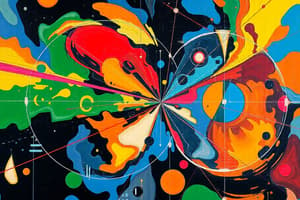Podcast
Questions and Answers
Explain why a recorded voice sounds different than when you hear yourself speak.
Explain why a recorded voice sounds different than when you hear yourself speak.
When you speak, sound waves reach your ears through the air and through your skull, providing a fuller sound compared to a recording.
If the air pressure caused by sound waves is not the same on both sides of the eardrum, what component of the ear corrects this?
If the air pressure caused by sound waves is not the same on both sides of the eardrum, what component of the ear corrects this?
The Eustachian tube.
Explain how the shape of the outer ear (pinna) aids in determining the direction of a sound.
Explain how the shape of the outer ear (pinna) aids in determining the direction of a sound.
The pinna funnels sound waves, and the brain interprets directional cues by analyzing differences in the sound received by each ear.
Describe the role of the semicircular canals in maintaining balance and detecting movement.
Describe the role of the semicircular canals in maintaining balance and detecting movement.
Outline the process by which the ear converts sound waves into nerve impulses that the brain can interpret.
Outline the process by which the ear converts sound waves into nerve impulses that the brain can interpret.
Explain how the ciliary muscles control the shape of the lens to focus on objects at varying distances.
Explain how the ciliary muscles control the shape of the lens to focus on objects at varying distances.
How does the brain merge the images received from each eye to create depth perception?
How does the brain merge the images received from each eye to create depth perception?
How does a concave lens correct short-sightedness (myopia)?
How does a concave lens correct short-sightedness (myopia)?
Describe the function of rods and cones in the retina and explain how they contribute to vision in varying light conditions.
Describe the function of rods and cones in the retina and explain how they contribute to vision in varying light conditions.
How do the iris and pupil work together to regulate the amount of light entering the eye?
How do the iris and pupil work together to regulate the amount of light entering the eye?
Explain the role of the cornea and lens in focusing light onto the retina.
Explain the role of the cornea and lens in focusing light onto the retina.
Explain how sensory receptors in your stomach communicate feelings of hunger or fullness.
Explain how sensory receptors in your stomach communicate feelings of hunger or fullness.
How do internal sensory receptors aid in maintaining homeostasis within the body?
How do internal sensory receptors aid in maintaining homeostasis within the body?
What distinguishes a sense from a sense organ, and how are they related?
What distinguishes a sense from a sense organ, and how are they related?
Describe the sequence of events that occur when you hear a phone ringing, from stimulus to response.
Describe the sequence of events that occur when you hear a phone ringing, from stimulus to response.
What is the difference between a voluntary and an involuntary response, and provide an example of each.
What is the difference between a voluntary and an involuntary response, and provide an example of each.
Explain how effectors facilitate the body's response to stimuli, providing examples of both fast and slow effector actions.
Explain how effectors facilitate the body's response to stimuli, providing examples of both fast and slow effector actions.
Explain how the body uses stimuli and responses to maintain survival.
Explain how the body uses stimuli and responses to maintain survival.
Describe the role of sensory receptors in converting various forms of stimuli into signals that the body can interpret.
Describe the role of sensory receptors in converting various forms of stimuli into signals that the body can interpret.
Imagine a scenario where an animal loses its sight. Discuss the potential implications for its survival and how other senses might compensate.
Imagine a scenario where an animal loses its sight. Discuss the potential implications for its survival and how other senses might compensate.
Flashcards
What is a stimulus?
What is a stimulus?
Any external or internal change that causes a reaction.
What is a response?
What is a response?
a reaction to a stimulus.
What are neurons?
What are neurons?
Specialised cells to conduct nerve impulses to their destination.
What are Effectors?
What are Effectors?
Signup and view all the flashcards
What happens if your stomach is empty?
What happens if your stomach is empty?
Signup and view all the flashcards
What are the five senses?
What are the five senses?
Signup and view all the flashcards
What do sensory receptors do?
What do sensory receptors do?
Signup and view all the flashcards
What are the five sense organs?
What are the five sense organs?
Signup and view all the flashcards
What is the stimulus and sense organ for vision?
What is the stimulus and sense organ for vision?
Signup and view all the flashcards
What is stimulus, and sense organ for hearing?
What is stimulus, and sense organ for hearing?
Signup and view all the flashcards
What is the pinna?
What is the pinna?
Signup and view all the flashcards
What is the Eustachian tube?
What is the Eustachian tube?
Signup and view all the flashcards
What are semicircular canals?
What are semicircular canals?
Signup and view all the flashcards
What are the three parts of the ear?
What are the three parts of the ear?
Signup and view all the flashcards
What does the cornea do?
What does the cornea do?
Signup and view all the flashcards
What does iris do?
What does iris do?
Signup and view all the flashcards
What does the lens do?
What does the lens do?
Signup and view all the flashcards
What is the retina?
What is the retina?
Signup and view all the flashcards
What are cones?
What are cones?
Signup and view all the flashcards
What are rods?
What are rods?
Signup and view all the flashcards
Study Notes
Lecture 22: The Lorentz Transformation
- Inertial Reference Frame (IRF) is one where Newton's First Law applies.
- A spaceship at constant velocity relative to a distant star exemplifies an IRF.
- An accelerating is not an example of an IRF.
- Frame S' moves at velocity ( v ) in the ( x ) direction relative to frame S, with origins overlapping at ( t=0 ).
- The Galilean Transformation inaccurately relates coordinates between moving reference frames.
- Galilean Transformation fails to preserve the speed of light.
- The Galilean Transformation does not reflect reality, and Maxwell's equations are not invariant under it.
The Lorentz Transformation
- Asserts that physics laws are identical in all inertial reference frames.
- Postulates a constant vacuum speed of light for every observer, no matter the light source's motion.
- Lorentz Transformation equations relate space and time coordinates between two inertial reference frames.
- ( \gamma ) approaches 1 at low speeds, turning the Lorentz transformation into the Galilean transformation.
- The Lorentz transformation upholds the speed of light.
- This transformation holds for speeds ( v < c ).
Inverse Lorentz Transformation
- Used to determine original coordinates ( (x,y,z,t) ) from transformed coordinates ( (x',y',z',t') ).
- Switch primed and unprimed coordinates and replace ( v ) with ( -v ) to derive the inverse Lorentz transformation.
Consequences
- Length contraction describes how an object appears shorter when moving versus at rest.
- The equation ( L = \frac{L_0}{\gamma} ) shows the relationship between observed length and proper length.
- Time dilation explains that moving clocks tick slower relative to stationary ones.
- Use the equation ( \Delta t = \gamma \Delta t_0 ) to relate time intervals in different reference frames.
Algorithmic Game Theory
- It is the study of multi-agent decision problems.
- Scenarios include auctions, network formation, selfish routing, social networks, elections.
Selfish Routing
- A network of roads where cost depends on congestion.
- Drivers are players aiming for the quickest route.
- Strategies involve choosing the path with the least cost.
- The problem is understanding the dynamics when all drivers choose routes selfishly.
Key Questions in Algorithmic Game Theory
- Does the system stabilize into an equilibrium?
- How does equilibrium compare to a centrally planned solution?
Congestion Games
- Defined by players, resources, and cost functions for each resource.
- Players are represented by ( N={1,..,n} ).
- The set of resources is represented by ( E ).
- ( \mathcal{S}_i \subseteq 2^E ) is the set of strategies for each player ( i ).
- ( c_e : \mathbb{N} \rightarrow \mathbb{R} ) is a cost function for resource ( e ), setting costs based on usage.
Strategy Profile
- Comprises a vector ( S=(S_1,..,S_n) ) where each ( S_i ) is a strategy for player ( i ).
- ( n_e(S)=|{i : e \in S_i}| ) indicates players using resource ( e ) in profile ( S ).
- Player i's cost is ( C_i(S)=\sum_{e \in S_i} c_e(n_e(S)) ).
Nash Equilibrium
- Exists when no player benefits from changing strategies alone.
- For Nash equilibrium, for all ( i ) and ( S'_i \in \mathcal{S}_i ), ( C_i(S) \le C_i(S'i, S{-i}) ) which means no unilateral deviation lowers cost.
- Denotes other players' strategies as ( (S'i, S{-i}) = (S_1,..,S_{i-1}, S'i, S{i+1},..,S_n) ).
- Every congestion game has a Nash equilibrium.
Proof of Nash Equilibrium
- A potential function ( \Phi(S) = \sum_{e \in E} \sum_{j=1}^{n_e(S)} c_e(j) ) is defined.
- When player ( i ) switches to ( S'_i ), cost changes and ( C_i(S) - C_i(S'i, S{-i}) ) equals the change in the potential function ( \Phi(S) - \Phi(S'i, S{-i}) ).
- The game reaches Nash equilibrium as the number of profiles is finite and the potential function decreases with beneficial deviations.
Pigou's Game
- Illustrates traffic routing between start S and target T with varying costs.
- In Nash equilibrium, all traffic uses the lower edge because it's perceived as the lowest cost route.
- Social optimum involves minimizing total cost by optimizing traffic distribution.
- It's determined by minimizing ( C(x) = x^2 - x + 1 ), leading to ( x = \frac{1}{2} ).
Price of Anarchy (PoA)
- A measurement of social welfare loss due to selfish players.
- The formula to calculate this is (PoA = \frac{\text{Cost of worst Nash equilibrium}}{\text{Cost of social optimum}}).
Braess's Paradox
- Even adding roads can worsen network efficiency.
- The Nash equilibrium in the original network involves traffic splitting evenly.
- Adding a zero-cost road changes the Nash equilibrium where all traffic uses the new, worsened route.
Fonction Logarithme Népérien
- The natural logarithm function, written as ln, is defined on ( ]0; +\infty[ ).
- The natural logarithm is the antiderivative of ( x \mapsto \frac{1}{x} ) that is zero at 1.
- ln is differentiable on ( ]0; +\infty[ ) and for all ( x > 0 ), ( ln'(x) = \frac{1}{x} ).
- ln is continuous on ( ]0; +\infty[ ).
- ( ln(1) = 0 ) and ( ln(e) = 1 ).
Algebraic Properties
- For all strictly positive real numbers a and b, and for any relative integer n, the following formulas are applicable.
- ( ln(ab) = ln(a) + ln(b) )
- ( ln(\frac{1}{a}) = -ln(a) )
- ( ln(\frac{a}{b}) = ln(a) - ln(b) )
- ( ln(a^n) = n \cdot ln(a) )
- ( ln(\sqrt{a}) = \frac{1}{2}ln(a) )
Natural Logarithm Study
- The ln function is strictly increasing on ( ]0; +\infty[ ).
- For all strictly positive real numbers a and b, ( ln(a) = ln(b) \Leftrightarrow a = b ).
- For all strictly positive real numbers a and b, ( ln(a) < ln(b) \Leftrightarrow a < b ).
Estadística Descriptiva
- Is a branch of statistics that focuses on summarizing and presenting data informatively.
- Aims to describe the key characteristics of a data set without generalizing to a broader population.
Descriptive Statistical Methods
- Frequency tables organize data into categories, displaying how often each appears.
- Graphs like histograms and bar graphs visually represent data distributions and category comparisons.
- Pie charts show the proportions of each category relative to the total.
- Scatter plots are used to examine the relationship between variables.
Measures of Central Tendency
- The formula to find the arithmetic mean is ( \mu = \frac{\sum_{i=1}^{N} X_i}{N} )
- Provide insight into the typical value of the data.
- The central value in an ordered data is the median.
- The most frequently occurring value is the mode.
Measures of Dispersion
- The distance between maximum and minimum values indicates the range.
- Variance measures dispersion around the mean, using the formula ( \sigma^2 = \frac{\sum_{i=1}^{N} (X_i - \mu)^2}{N} ).
- Standard deviation is the square root of variance that is described by the formula, ( \sigma = \sqrt{\frac{\sum_{i=1}^{N} (X_i - \mu)^2}{N}} )
Measures of Position
- Quartiles (Q1, Q2, Q3) divide data into four equal parts.
- Percentiles segment data into one hundred equal parts.
Static Equilibrium
- Requires both zero net force and zero net torque.
- Equations are ( \sum \vec{F} = 0 ) and ( \sum \vec{\tau}=0 ).
- These expand to ( \sum F_x = 0 ), ( \sum F_y = 0 ), and ( \sum \tau_z = 0 ).
- Center of gravity is the balance point of an object's weight.
- For homogeneous objects, it's at the geometric center.
Problem-Solving Strategy
- Resolve forces into x and y components after drawing a free-body diagram.
- You then apply the equilibrium conditions.
- You should check the work to logically make sure answers are reasonable.
Teorema de Bayes
- Relates the conditional and marginal probabilities of random events.
- ( P(A|B) = \frac{P(B|A)P(A)}{P(B)} )
Derivation of Bayes' Theorem
- Probability of A given B = probability of intersection of A and B divided by the probability of B.
- Solving these equations leads to Bayes' Theorem.
Example of Bayes' Theorem
- To determine the probability of having a rare disease given a positive test result, use the law of total probability to find ( P(+) ).
- Bayes' Theorem computes the likelihood with considerations for true positives, false positives, and disease rarity.
Lecture 1 - Probabilistic ML
- It uses probability to handle uncertainty, learn, and predict.
- It is used because uncertainty is unavoidable and it handles missing data.
- It uses a principled method to combine data and prior knowledge : ( P(\theta \mid \mathcal{D})=\frac{P(\mathcal{D} \mid \theta) P(\theta)}{P(\mathcal{D})} )
- It relies on probability, statistics, linear algebra, and optimization.
- Models include linear and logistic regression, Gaussian mixtures, and hidden Markov models.
- Algorithms include Expectation Maximization, Monte Carlo, and Variational Inference.
Probability
- Sample space is all possible experiment outcomes. An event space is a subset of outcomes.
- A probability function assigns a probability to each event with axioms.
Random Variable
- Maps outcomes to real numbers. Discrete random variables have finite values.
- Bernoulli, binomial, and Poisson distributions are examples of discrete random variables.
- The probability mass function (PMF) defines probabilities for discrete random variables with specific properties.
Continuous Random Variable
- Continuous random variables can take any value in a continuous range.
- Examples include Gaussian, exponential, and uniform distributions.
- Instead of probability, continuous variables use probability density functions (PDFs).
Devoir 1 - IFT 2420
- This is an assignment due on Friday, January 26, at 23:59.
- It can be done individually or in teams of 2.
- Code must be commented, compiled, and tested and include the student's name and NI.
Question 1
- The task is to implement functions in 32-bit RISC-V assembly including finding string length, comparing strings, and copying strings.
Question 2
- Code (in C) must be translated into RISC-V, illustrating the stack during loop execution.
Question 3
- Design a C program to dynamically allocate an integer array, populate it with user inputs, and compute the average of even numbers, using separate functions for allocation, input, calculation, and deallocation.
Question 4
- Write a program that creates an array of 5 students, takes inputs for each student, and calculates the average grade of all students, and sorts the students by grade.
Machine Learning: A Probabilistic Perspective
- Machine learning develops algorithms for computers to learn from data.
- Data mining finds patterns in large datasets.
- The difference between machine learning and data mining is ML focuses on prediction and DM focuses on knowledge discovery.
Types of Learning
- Supervised learning: predict output ( y ) from input ( \mathbf{x} ) using labeled data ( (\mathbf{x}_i, y_i) ).
- Classification: ( y_i ) is discrete and in ( {1, \dots, C} ).
- Regression: ( y_i ) is continuous and in ( \mathbb{R} ).
- Unsupervised learning: discover structure from unlabeled data ( \mathbf{x}_i ).
- Clustering: group similar examples.
- Dimensionality reduction: find lower-dimensional representations.
- Reinforcement learning: select actions to maximize a reward.
Probabilistic Perspective
- Uses probability theory to model uncertainty.
- Prediction is obtained via ( y^* = \arg \max_y p(y \mid \mathbf{x}^*) ) using Bayes' Rule.
Supervised Learning
- Task is to learn a function that maps inputs 𝐱 to outputs y from a supervised dataset.
- Algorithms such as email spam detectors are used.
Unsupervised Learning
- The task is to learn the underlying data structure ( \mathcal{D} = {\mathbf{x}i}{i=1}^N ).
- Algorithms such as customer segmentation are used.
Reinforcement Learning
- Task is to learn action selection for maximum reward.
Studying That Suits You
Use AI to generate personalized quizzes and flashcards to suit your learning preferences.




